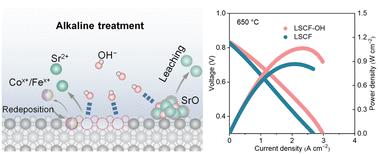Activating the cathode for solid oxide fuel cells by selective removal of surface strontium
IF 9.5
2区 材料科学
Q1 CHEMISTRY, PHYSICAL
引用次数: 0
Abstract
Sr segregation in perovskite cathodes depletes active sites for the oxygen reduction reaction (ORR) and accelerates performance degradation in solid oxide fuel cells (SOFCs). La0.6Sr0.4Co0.2Fe0.8O3−δ (LSCF), a representative cathode material for intermediate-temperature SOFCs, suffers from surface Sr segregation, leading to electrochemical deterioration. Here, we present a surface engineering strategy based on alkaline treatment to selectively remove Sr-rich surface species while preserving the bulk perovskite structure. Structural and electrochemical analyses using LSCF as a model cathode reveal that this treatment exposes catalytically active B-site (Co/Fe) cations and eliminates Sr-derived surface species, thereby optimizing ORR kinetics. The treated LSCF cathode exhibits a 27–40% reduction in area-specific resistance (ASRp) over the temperature range of 700–550 °C and maintains stable performance during 150 h of operation. A single fuel cell with the modified cathode achieves a peak power density of 1.07 W cm−2 at 650 °C, a 23% improvement over pristine LSCF. This approach is applicable to the commercial LSCF cathode and offers a promising route for developing high-performance cathode materials for intermediate-temperature SOFCs.

通过选择性去除表面锶来激活固体氧化物燃料电池的阴极
钙钛矿阴极中的锶偏析耗尽了氧还原反应(ORR)的活性位点,加速了固体氧化物燃料电池(sofc)的性能下降。La0.6Sr0.4Co0.2Fe0.8O3−δ (LSCF)是中温sofc的代表性正极材料,其表面Sr偏析导致电化学劣化。在这里,我们提出了一种基于碱性处理的表面工程策略,以选择性地去除富sr表面物质,同时保留大块钙钛矿结构。使用LSCF作为模型阴极的结构和电化学分析表明,这种处理暴露了催化活性b位(Co/Fe)阳离子,消除了sr衍生的表面物质,从而优化了ORR动力学。在700-550°C的温度范围内,处理后的LSCF阴极的面积比电阻(ASRp)降低了27-40%,并在150小时的工作时间内保持稳定的性能。在650°C时,使用改性阴极的单个燃料电池的峰值功率密度为1.07 W cm - 2,比原始LSCF提高了23%。该方法适用于商用LSCF阴极,为中温sofc高性能阴极材料的开发提供了一条有前景的途径。
本文章由计算机程序翻译,如有差异,请以英文原文为准。
求助全文
约1分钟内获得全文
求助全文
来源期刊

Journal of Materials Chemistry A
CHEMISTRY, PHYSICAL-ENERGY & FUELS
CiteScore
19.50
自引率
5.00%
发文量
1892
审稿时长
1.5 months
期刊介绍:
The Journal of Materials Chemistry A, B & C covers a wide range of high-quality studies in the field of materials chemistry, with each section focusing on specific applications of the materials studied. Journal of Materials Chemistry A emphasizes applications in energy and sustainability, including topics such as artificial photosynthesis, batteries, and fuel cells. Journal of Materials Chemistry B focuses on applications in biology and medicine, while Journal of Materials Chemistry C covers applications in optical, magnetic, and electronic devices. Example topic areas within the scope of Journal of Materials Chemistry A include catalysis, green/sustainable materials, sensors, and water treatment, among others.
 求助内容:
求助内容: 应助结果提醒方式:
应助结果提醒方式:


